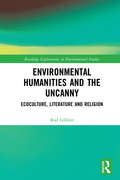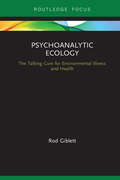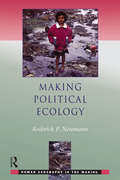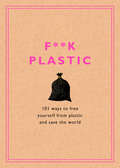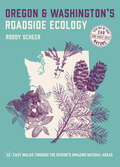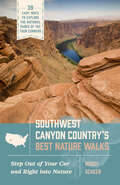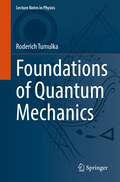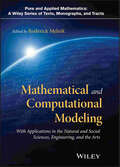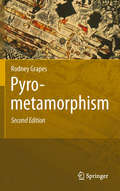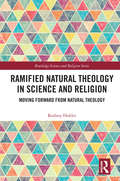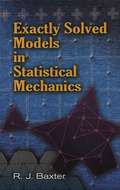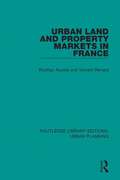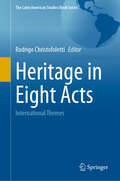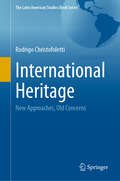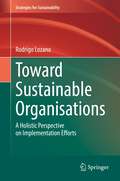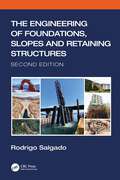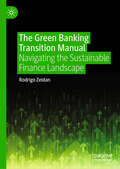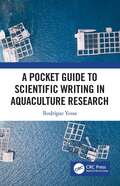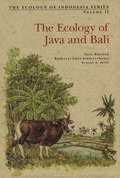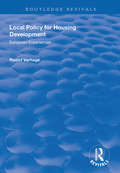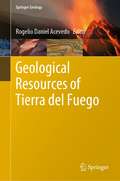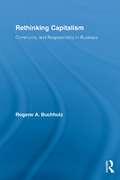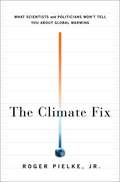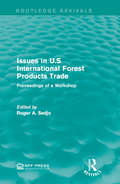- Table View
- List View
Environmental Humanities and the Uncanny: Ecoculture, literature and religion (Routledge Explorations in Environmental Studies)
by Rod GiblettSigmund Freud’s essay on the uncanny is celebrating a century. It is arguably his greatest and most fruitful contribution to the study of culture and the environment. Environmental Humanities and the Uncanny brings into the open neglected aspects of the uncanny in Freud’s famous essay in its centenary year and in the work of those before and after him, such as Friedrich Schelling, Walter Benjamin, E. T. A. Hoffmann and Bram Stoker. This book does so by focussing on religion, especially at a time and for a world in which some sectors of the monotheisms are in aggressive, and sometimes violent, contention against those of other monotheisms, and even against other sectors within their own monotheism. The chapter on Schelling’s uncanny argues that monotheisms come out of polytheism and makes the plea for polytheism central to the whole book. It enables rethinking the relationships between mythology and monotheistic and polytheistic religions in a culturally and politically liberatory and progressive way. Succeeding chapters consider the uncanny cyborg, the uncanny and the fictional, and the uncanny and the Commonwealth, concluding with a chapter on Taoism as a polytheistic religion. Building on the author’s previous work in Environmental Humanities and Theologies in bringing together theories of religion and the environment, this book will be of great interest to students and scholars of the environmental humanities, ecocultural studies and religion.
Psychoanalytic Ecology: The Talking Cure for Environmental Illness and Health (Routledge Focus on Environment and Sustainability)
by Rod GiblettPsychoanalytic Ecology applies Freudian concepts, beginning with the uncanny, to environmental issues, such as wetlands and their loss, to alligators and crocodiles as inhabitants of wetlands, and to the urban underside. It also applies other Freudian concepts, such as sublimation, symptom, mourning and melancholia, to environmental issues and concerns. Mourning and melancholia can be experienced in relation to wetlands and to their loss. The city is a symptom of the will to fill or drain wetlands. This book engages in a talking cure of psychogeopathology (environmental psychopathology; mental land illness; environ-mental illness) manifested also in industries, such as mining and pastoralism, that practice greed and gluttony. Psychoanalytic Ecology promotes gratitude for generosity as a way of nurturing environ-mental health to prevent the manifestation of these psychogeopathological symptoms in the first place. Melanie Klein’s work on anal sadism is applied to mining and Karl Abraham’s work on oral sadism to pastoralism. Finally, Margaret Mahler’s and Jessica Benjamin’s work on psycho-symbiosis is drawn on to nurture bio- and psycho-symbiotic livelihoods in bioregional home habitats of the living earth in the symbiocene, the hoped-for age superseding the Anthropocene. Psychoanalytic Ecology demonstrates the power of psychoanalytic concepts and the pertinence of the work of several psychoanalytic thinkers for analysing a range of environmental issues and concerns. This book will be of great interest to students and scholars of environmental psychology, psychoanalysis and the environmental humanities.
Making Political Ecology (Human Geography in the Making)
by Rod NeumannMaking Political Ecology presents a comprehensive view of an important new field in human geography and interdisciplinary studies of nature-society relations. Tracing the development of political ecology from its origins in geography and ecological anthropology in the 1970s, to its current status as an established field, the book investigates how late twentieth-century developments in social and ecological theories are brought together to create a powerful framework for comprehending environmental problems.Making Political Ecology argues for an inclusionary conceptualization of the field, which absorbs empirical studies from urban, rural, First World and Third World contexts and the theoretical insights of feminism, poststructuralism, neo-Marxism and non-equilibrium ecology. Throughout the book, excerpts from the writings of key figures in political ecology provide an empirical grounding for abstract theoretical concepts.Making Political Ecology will convince readers of political ecology's particular suitability for grappling with the most difficult questions concerning social justice, environmental change and human relationships with nature.
F**k Plastic: 101 Ways to Free Yourself from Plastic and Save the World
by Rodale SustainabilityThe Zero-Waste Guide to Life!Is the thought of the 51 trillion pieces of plastic in our oceans keeping you up at night? Don't panic! The war on plastic has begun and you can help. In this book you'll find 101 little things you as an individual can do to avoid single-use plastics and help save the world. You'll find sweet and simple ideas like carrying around your own cutlery, getting ice cream in a cone instead of a cup, and buying loose doughnuts or pastries for snacks instead of packaged sweets. Plus, you'll find 101 simple ways to cut plastic from:-FOOD AND DRINK: freeze fresh veggies rather than buying frozen ones, and buy beeswax wrap instead clingfilm-AROUND THE HOUSE: buy bars of soap instead of hand dispensers and swap scourers for natural cloths-YOUR LIFESTYLE: how to throw a plastic-free party and find good plastic-free make-upWith easy, no-nonsense steps for cutting plastic out of your everyday life, this is the perfect gift for anyone ready to start fighting the war on plastic. These easy nudges will guide you to change your habits bit by bit so that cutting out plastics becomes second nature.
Oregon and Washington's Roadside Ecology: 33 Easy Walks Through the Region's Amazing Natural Areas
by Roddy ScheerDiscover natural history secrets hiding in plain sight Have you ever seen a raging river disappear completely into a lava tube? Petrified subtropical plants in the middle of a high desert? Do you know how a 10,000-year-old argillite boulder can wind up 800 miles away from any similar rocks? In this insightful guide, environmental journalist and photographer Roddy Scheer reveals the hidden stories of the Pacific Northwest&’s unique ecosystems and teaches you how to &“read a landscape,&” as you explore 33 spectacular natural areas. All hikes are within easy walking distance of the road, less than two miles long, and include clues to deciphering the terrain—making Oregon and Washington&’s Roadside Ecology a must-have guide to some of the area&’s most spectacular and unusual natural sights.
Southwest Canyon Country’s Best Nature Walks: 39 Easy Ways to Explore the National Parks of the Four Corners
by Roddy ScheerExplore some of the easiest and most rewarding hikes through Utah, Arizona, and Colorado's otherworldly landscapes—with descriptions of the unique flora, fauna, and geology any hiker can discover along the trail. From the towering cliffs of Zion to the ancient dwellings of Mesa Verde; from the bighorn sheep of Arches National Park to the Martian-looking landscapes of the Petrified Forest—each trail featured in Southwest Canyon Country's Best Nature Walks beckons with the promise of adventure and discovery. But these are not the epic treks of seasoned adventurers or the grueling expeditions of intrepid explorers. Instead, these are brief excursions—often chosen for being less crowded and for their proximity to the road—that can be enjoyed by families, solo travelers, and nature enthusiasts of all ages and abilities. Whether you're seeking a peaceful retreat into the wilderness or simply craving a breath of fresh air, this book has something for everyone.
Foundations of Quantum Mechanics (Lecture Notes in Physics #1003)
by Roderich TumulkaThis book introduces and critically appraises the main proposals for how to understand quantum mechanics, namely the Copenhagen interpretation, spontaneous collapse, Bohmian mechanics, many-worlds, and others. The author makes clear what are the crucial problems, such as the measurement problem, related to the foundations of quantum mechanics and explains the key arguments like the Einstein-Podolsky-Rosen argument and Bell’s proof of nonlocality. He discusses and clarifies numerous topics that have puzzled the founding fathers of quantum mechanics and present-day students alike, such as the possibility of hidden variables, the collapse of the wave function, time-of-arrival measurements, explanations of the symmetrization postulate for identical particles, or the nature of spin. Several chapters are devoted to extending the different approaches to relativistic space-time and quantum field theory. The book is self-contained and is intended for graduate students and researchers who want to step into the fundamental aspects of quantum physics. Given its clarity, it is accessible also to advanced undergraduates and contains many exercises and examples to master the subject.
Mathematical and Computational Modeling
by Roderick MelnikIllustrates the application of mathematical and computational modeling in a variety of disciplines With an emphasis on the interdisciplinary nature of mathematical and computational modeling, Mathematical and Computational Modeling: With Applications in the Natural and Social Sciences, Engineering, and the Arts features chapters written by well-known, international experts in these fields and presents readers with a host of state-of-the-art achievements in the development of mathematical modeling and computational experiment methodology. The book is a valuable guide to the methods, ideas, and tools of applied and computational mathematics as they apply to other disciplines such as the natural and social sciences, engineering, and technology. Mathematical and Computational Modeling: With Applications in the Natural and Social Sciences, Engineering, and the Arts also features: Rigorous mathematical procedures and applications as the driving force behind mathematical innovation and discovery Numerous examples from a wide range of disciplines to emphasize the multidisciplinary application and universality of applied mathematics and mathematical modeling Original results on both fundamental theoretical and applied developments in diverse areas of human knowledge Discussions that promote interdisciplinary interactions between mathematicians, scientists, and engineers Mathematical and Computational Modeling: With Applications in the Natural and Social Sciences, Engineering, and the Arts is an ideal resource for professionals in various areas of mathematical and statistical sciences, modeling and simulation, physics, computer science, engineering, biology and chemistry, industrial, and computational engineering. The book also serves as an excellent textbook for graduate courses in mathematical modeling, applied mathematics, numerical methods, operations research, and optimization.
Pyrometamorphism
by Rodney Grapes1000 °C) and low pressures (< 2 kb) and typically results in the formation of "burnt" and fused rocks termed buchites, paralavas, clinkers and fulgarites. It is typically associated with shallow basaltic intrusions (contact aureoles, xenoliths,) combustion of carbonaceous matter, lightning strikes, and is also found in meteorites. During pyrometamorphism, the sequence of heating and cooling is greatly condensed favouring the preservation of a variety of stranded reaction microstructures that reflect disequilibrium reaction kinetics with metastable and mineral crystallisation. This second edition includes the latest developments in the study of pyrometamorphism derived from over 60 new references and accompanied with over 20 new illustrations.
Ramified Natural Theology in Science and Religion: Moving Forward from Natural Theology (Routledge Science and Religion Series)
by Rodney HolderThis book offers a rationale for a new ‘ramified natural theology’ that is in dialogue with both science and historical-critical study of the Bible. Traditionally, knowledge of God has been seen to come from two sources, nature and revelation. However, a rigid separation between these sources cannot be maintained, since what purports to be revelation cannot be accepted without qualification: rational argument is needed to infer both the existence of God from nature and the particular truth claims of the Christian faith from the Bible. Hence the distinction between ‘bare natural theology’ and ‘ramified natural theology.’ The book begins with bare natural theology as background to its main focus on ramified natural theology. Bayesian confirmation theory is utilised to evaluate competing hypotheses in both cases, in a similar manner to that by which competing hypotheses in science can be evaluated on the basis of empirical data. In this way a case is built up for the rationality of a Christian theist worldview. Addressing issues of science, theology and revelation in a new framework, this book will be of keen interest to scholars working in Religion and Science, Natural Theology, Philosophy of Religion, Biblical Studies, Systematic Theology, and Science and Culture.
Exactly Solved Models in Statistical Mechanics
by Rodney J. BaxterThis text explores the solution of two-dimensional lattice models. Topics include basic statistical mechanics, Ising models, the mean field model, the spherical model, ice-type models, corner transfer matrices, hard hexagonal models, and elliptic functions. The author has updated the 1989 version with a new chapter, "Subsequent Developments," for the 2007 edition.
Urban Land and Property Markets in France (Routledge Library Editions: Urban Planning #1)
by Rodrigo Acosta Vincent RenardOriginally published in 1994, Urban Land and Property Markets in the United Kingdom, adopts a perspective that encompasses the distinctive nature of the legal framework, land law, property market and procedures of Scotland, England and Wales. The book provides detailed accounts of the structure of property, planning and tax law governing urban land and property markets, registration procedures and transactions charges, market processes and how they all work in practice. The book is based on a report commissioned by the German Federal Government as part of a five-country study completed in 1991.
Heritage in Eight Acts: International Themes (The Latin American Studies Book Series)
by Rodrigo ChristofolettiHeritage in Eight Acts brings together contributions on cultural heritage at an international level with an emphasis on Latin American and Ibero-American studies, addressing points of convergence between the local and the global in an accessible and direct way. It discusses themes that have gained importance on the heritage preservation agenda, signaling how Latin America and Europe have expanded their connections and actions in favor of the multiplicity of heritage. Eight scholars from diverse backgrounds bring critical and nuanced understandings of heritage to the context of international relations. From architecture to history and from archeology to art history, each contribution displays methodological creativity and analytical depth. The result is a synthesis with the impact of showing how points of connection can bring Latin America closer to Europe, but not from a relationship of subalternity, but of shared protagonism.
International Heritage: New Approaches, Old Concerns (The Latin American Studies Book Series)
by Rodrigo ChristofolettiThis book celebrates decades of safeguarding cultural heritage and reckons with reconfigurations and shifts that have shaped the field and understandings of it. The author reflects on a career of safeguarding heritage, offering perspectives from the positions of consumer, researcher, educator, and communicator and at a range of scales, from local-level debates to macro-level perspectives on the role of heritage preservation in international relations. The book situates heritage preservation in the context of soft power and the international system and examines how it intersects with cultural diplomacy. These interrelationships crystalize in the illicit trafficking of cultural goods, inspiring reflections on private and common goods, interoperability, and decoloniality. Grounded in nuanced understandings of "world heritage" and "heritage of humanity", the author critically examines the foundation, trajectory, and remit of UNESCO and highlights cases of cultural and natural heritage, language, and tourism. These discussions in turn inform treatments of two timely topics: intangible heritage of and for refugees and the treatment of statues and symbols of colonizers. By integrating diverse themes that are frequently treated independently, International Heritage: New Approaches, Old Concerns is a resource for researchers and practitioners looking to understand the foundations, current debates, and imminent challenges facing communities that aim to safeguard global cultural heritage.
Toward Sustainable Organisations: A Holistic Perspective on Implementation Efforts (Strategies for Sustainability)
by Rodrigo LozanoThe book is one of the first ones focussing on how organisations (civil society, corporations, and public sector ones) are contributing to sustainability. The book starts by providing a discussion of the four dimensions of sustainability (economic, environmental, social, and time). The second chapter focusses on what organisations are, their system elements (e.g. operations and production, management and strategy, and governance), stakeholders, relationships within and between organisations (ranging from competition to collaboration), and a framework for organisations to understand and map how they can contribute to sustainability. The third chapter discusses the twenty-four main tools, initiatives, and approaches (TIAs) that have been developed for organisations to contribute to sustainability, such as Circular Economy, Corporate Social Responsibility, Environmental Management Systems, and Sustainability Reporting. The fourth chapter focusses on organisational change management for sustainability, including types of change, drivers for change, resistance to change, incorporation, and institutionalisation. The fifth chapter presents empirical evidence on what civil society organisations have contributed to sustainability, from priorities and impacts, TIAs, external stimuli, and internal factors, drivers for change, starts of change, and development of change. The sixth chapter presents empirical evidence on what corporations have contributed to sustainability, from priorities and impacts, TIAs, external stimuli, and internal factors, drivers for change, starts of change, and development of change. The seventh chapter presents empirical evidence on what public sector organisations have contributed to sustainability, from priorities and impacts, TIAs, external stimuli, and internal factors, drivers for change, starts of change, and development of change. The last chapter provides the conclusions of the book.The book is aimed at providing a multi-level, dynamic, and holistic perspective on the contributions of organisations to sustainability. The book's uniqueness lies in analysing organisations’ efforts to become more sustainability oriented and contribute to making societies more sustainable through systems thinking, TIAs, and change processes.
The Engineering of Foundations, Slopes and Retaining Structures
by Rodrigo SalgadoThe Engineering of Foundations, Slopes and Retaining Structures rigorously covers the construction, analysis, and design of shallow and deep foundations, as well as retaining structures and slopes. It includes complete coverage of soil mechanics and site investigations. This new edition is a well-designed balance of theory and practice, emphasizing conceptual understanding and design applications. It contains illustrations, applications, and hands-on examples that continue across chapters. Soil mechanics is examined with full explanation of drained versus undrained loading, friction and dilatancy as sources of shear strength, phase transformation, development of peak effective stress ratios, and critical-state and residual shear strength. The design and execution of site investigations is evaluated with complete discussion of the CPT and SPT. Additional topics include the construction, settlement and bearing capacity of shallow foundations, as well as the installation, ultimate resistance and settlement of deep foundations. Both traditional knowledge and methods and approaches based on recent progress are available. Analysis and design of retaining structures and slopes, such as the use of slope stability software stability calculations, is included. The book is ideal for advanced undergraduate students, graduate students and practicing engineers and researchers.
The Green Banking Transition Manual: Navigating the Sustainable Finance Landscape
by Rodrigo ZeidanThe Green Banking Transition Manual sets the green banking standard for academic and professional audiences. Dr. Zeidan connects conventional financial indicators with green banking to present the practical case for sustainable finance. His insightful approach demonstrates that assessing environmental indicators is necessary for prudent banking business and not a &‘nice-to-have&’ attachment. This book will soon be the central manual for all involved in green banking and those who want to be involved in the future.
A Pocket Guide to Scientific Writing in Aquaculture Research
by Rodrigue YossaWriting for a high-quality scientific aquaculture publication is challenging, and many students and early career aquaculture scientists find the task daunting. Expanding on his popular workshop on Improving Scientific Writing at the 2017 World Aquaculture conference, Rodrigue Yossa provides new researchers with all the tools they need to write abstracts and a variety of articles (original, research reports, magazines, working papers, conference proceedings and more). He also takes the reader step-by-step through the process of reviewing submitted manuscripts and replying to reviewers, as well as understanding research ethics. Each section is accompanied by examples, and attention is focused on providing advice on grammar, how to focus your paper and possible loopholes when writing. A Pocket Guide to Scientific Writing in Aquaculture Research offers a lifeline to aquaculture students and early career researchers getting a grasp on the basics of science communication through writing.
The Ecology of Java and Bali
by Roehayat Emon Soeriaatmadja Suraya A. Afiff Tony WhittenThe Ecology of Java and Bali distills for the first time the information found in nearly 3,000 scholarly works relevant to an understanding of the full range of natural and man-made ecosystems on these islands--many of them available only in Dutch, German or Indonesian. It also contains the results of original research, interviews and personal experience. It will be useful to resource managers, ecologists and government planners, as well as to all others interested in the region.Java and Bali are the best known of all the islands in the Indonesian archipelago. Nowhere else in the country are ecological issues of such importance, and nowhere else is there a better chance of the major development problems being solved. This is because Java has the greatest concentration of development projects, the densest population, excellent human resources, and the interest of many of the most powerful decision makers. Bali, meanwhile, has the eyes of the world on it as an important tourist destination enjoyed by both domestic and foreign visitors.
Local Policy for Housing Development: European Experiences (Routledge Revivals)
by Roelof VerhageThis title was first published in 2002: When a developer wants to realize a housing scheme, what can the local planning authority do to assure that the resulting residential environment is of a high quality? This book explores the question through a cross-national comparison of housing development processes in The Netherlands, the United Kingdom, Germany and France. It analyzes how decisions about the residential environment are made in different situations, and by whom. By applying this analysis to housing development processes in different countries, the book paints a picture of how public policy and market mechanisms together influence the development of housing. From this, conclusions are drawn about how local planning authorities can achieve their objectives concerning the quality of housing areas.
Geological Resources of Tierra del Fuego (Springer Geology)
by Rogelio Daniel AcevedoThe CADIC’s Geological Resources Program will soon turn 40 years of fruitful development. During this period many projects were carried out and others remain to be implemented. In the course of time three generations of researchers have been formed. Mentioning names would be unfair to those that could be involuntarily omitted. There is still a long way to go. The eagerness for knowledge should not stop. This book is a tribute to all those people who have worked in the different projects of pure and applied science, and educational, and human resources training, granted to this founding program and associated laboratories of the regional center of CONICET in Ushuaia, Tierra del Fuego, Argentina. The twenty papers which constitute this book have a genuine Latin appeal, having been written by 50 authors based in Argentina and Spain. All this contributions are concerned with Fuegian geological resources. Everyone concerned with this work hopes that it will prove a fitting and lasting memorial to Nacho Subías, whose personal contribution to our knowledge of this geology was outstanding.
Rethinking Capitalism: Community and Responsibility in Business (Routledge Studies in Business Ethics)
by Rogene BuchholzGiven the recent financial meltdown and continuing economic problems the country and the world are facing, Rethinking Capitalism is particularly relevant. With the government having bailed out banks and other financial institutions as well as automobile companies, and anger over the compensation and severance packages provided to the managers of failed institutions in light of growing inequalities and continued high unemployment in American society, many are wondering if self-interest driven free-market capitalism is still viable. While there is some support for more active government regulation of financial and other institutions, there is also significant opposition to such an approach as new political movements gain strength. Are there other alternatives to create a more responsible capitalism that serves the entire society? Rethinking Capitalism questions the individualistic assumptions of a capitalist society and offers a new way to understand capitalism that entails a new role for business based on community and responsibility. Using classical American Pragmatism as a philosophical framework for capitalism, Professor Buchholz analyzes the history of capitalistic thought and proposes that we recast management as a profession akin to law and medicine oriented toward serving the public rather than just maximization of shareholder wealth. Buchholz challenges the way we understand capitalism with its emphasis on the creation of economic wealth and growth to the exclusion of other important goals and champions a new approach to the creation of a more sustainable and responsible functioning of the capitalistic system, the corporate organization, and its management.
The Hurricane (Routledge Revivals)
by Roger A PielkeFirst published in 1990, this book describes the nature of the hurricane, one of the world's most dangerous weather hazards. It examines the formation, development, movement, and impact of these tropical cyclones, and assess the ability of science to describe, forecast, and control them.
The Climate Fix: What Scientists and Politicians Won't Tell You About Global Warming
by Roger A. Pielke Jr.In The Climate Fix, Roger Pielke, Jr., a political scientist and a world-renowned expert on he intersection of politics and science, dissects the climate debate and diagnoses what has gone wrong and who's to blame for the mess. His answers will surprise you--it is the people who are best positioned to see clearly why we need to respond to climate change who are, more often than not, the people who get in the way of anything being accomplished. How is that possible? Quite simply, it's because most supporters of action on climate change, whether scientists, politicians, or activists, have gotten caught up in a vicious cycle. It begins with the belief that there is insufficient political will for action. Fixing this, it is assumed, requires that everyone agree on all aspects of climate change--both the dangers and the remedies. Accomplishing that means scaring people in the hope that fear will accomplish what reason has not. Fear often requires politicizing science, shaping its presentation in an effort to motivate a specific political outcome. But rather than making action more likely the posturing reinforces a state of inaction. Thus the cycle continues, and its malign influence can be felt in all quarters, from the halls of government and academia to the newspaper and your favorite dog. Pielke lays these problems bare for all to see. But he does more than just wag his finger. The Climate Fix presents first steps on a better path, one that returns to what really matters in the climate debate: expanding energy access (including for the 1.3 billion people worldwide who have none) and increasing energy security while lowering costs through technological innovation. Without those goals, Pielke argues, well never wean ourselves off carbon-heavy energy, whatever the hard-core environmentalists say. With them, we can not only help save our own lives but also improve everyone's, and turn a vicious cycle into a virtuous one. It is time to do something about climate change. We can keep trying to do it the old way, or we can try something new, something offensive to neither our livelihoods nor our common sense. The choice, even after years of muddy debate, should be clear. Which will you choose?
Issues in U.S International Forest Products Trade: Proceedings of a Workshop (Routledge Revivals)
by Roger A. SedjoAfter World War two, the United States became integrates into the world forest economy however the complexity of their trade agreements introduced several issues which needed to be addressed by world forestry policy. Originally published in 1981, this study delves into important issues related to forest resources and trade such as the future role of the United States in the world forest economy, trade restriction and U.S log exports. This title will be of interest to students of Environmental Studies and Economics.
